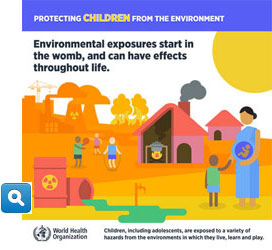1.7 Million Deaths Annually of Children under Five Are Linked to the Environment Says World Health Organization
BY ALLISON KOZICHAROW AND BERNICE BORN
T

WiRED Editorial
In the United States, there is currently a struggle over funding for the U.S. Environmental Protection Agency (EPA), the government agency that monitors and regulates pollution in all its forms: water, air, soil and more. Much of the discussion recently has been about the relationship between EPA’s efforts and climate change. The overwhelming consensus among professional scientists, who offer thousands of empirical studies in evidence, is that pollution contributes materially to climate change. Period.
WiRED stands firmly with advocates who support pollution controls to minimize the acceleration of climate change. Apart from the impact on climate, however, as the WHO report makes clear in this article, pollution has a huge and immediate impact on human health. Especially embryos, who have not yet set foot on the earth, and vulnerable young children are significantly affected by pollution. The studies are irrefutable. WiRED believes it is incumbent on all governments to control pollution at its source for the sake of the planet and for the health of its inhabitants. Controlling all forms of pollution will improve human health and save Earth from the devastation of a changing climate.

wo new reports from the World Health Organization (WHO) determined that every year Earth’s polluted environment accounts for 26% of deaths of children under five.
“A polluted environment is a deadly one — particularly for young children,” says
Dr. Margaret Chan, WHO Director-General. “Their developing organs and immune systems, and smaller bodies and airways, make them especially vulnerable to dirty air and water.”
 Credit: World Health Organization
Credit: World Health Organization
Children are particularly susceptible to environmental contaminants due to their rapid development during the fetal period and through early childhood. Environmental exposures start in the womb and can have effects throughout life, causing reduced lung capacity, asthma, cancers, chronic respiratory illnesses, cardiovascular disease and stroke.
Children are affected by climate change, air pollution, UV radiation, hazardous wastes and chemicals, materials used in building and renovation, and poor water, sanitation and hygiene. For example, nearly a million children die from pneumonia each year, with half of those deaths linked to air pollution.
WiRED International emphasizes disease prevention through healthy environments in many of its modules such as asthma, clean water, smoking and cancer. Also, there are actions individuals can take — even in their own homes and lifestyles — to minimize environmental risks to their health. WiRED’s modules point to ways everyone can address hazards from the environment.
WiRED believes that education and prevention ensure healthier environments and healthier people, and we will continue regularly to post web stories on climate change.

WHO: 10 Facts on Children’s Environmental Health
- More than 1 in 4 child deaths could be prevented by cleaning up the environment.
- Asthma prevalence in children is increasing worldwide.
- Air pollution is the greatest environment risk to children’s health.
- Access to safe water, sanitation and hygiene could prevent 361,000 child death from diarrhea.
- Acute childhood poisoning from pesticides can be life-threatening.
- Malaria caused more than 300,000 deaths in children under 5 in 2015.
- Lead is one of the most harmful chemicals, especially to young children.
- Unintentional poisonings cause an estimated 23,000 deaths in children under 5 every year.
- Early exposure to environmental risks contributes
to childhood cancers.
- Climate change increases the risk of disease, especially for children in developing countries.

^ Back to the Top |











